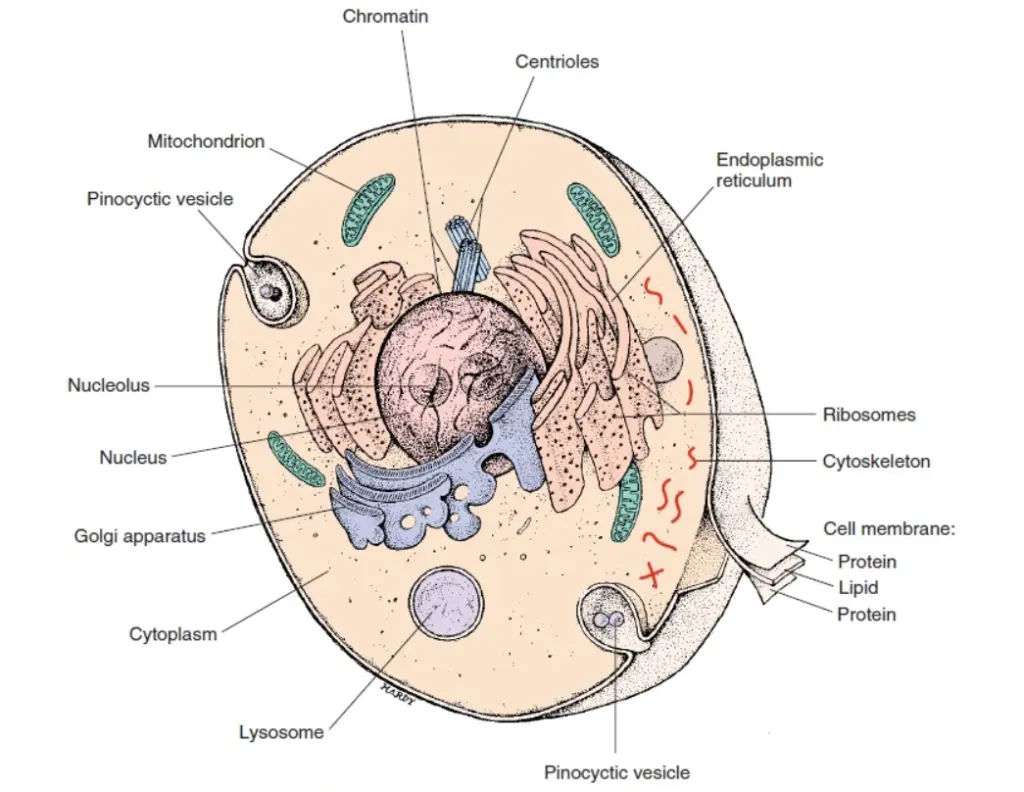Cells are the fundamental units of life, and they are found in all living organisms. They come in various shapes and sizes, but all cells share common structures and functions that allow them to perform the essential processes necessary for life. Let’s explore the structure and functions of cells and their organelles in detail:

Figure: The Typical Cell’s Structural Organization
1. Cell Membrane (Plasma Membrane):
Structure: The cell membrane is a phospholipid bilayer with embedded proteins. It surrounds the cell, separating its internal environment from the external surroundings.
Function: The cell membrane controls the passage of substances in and out of the cell, maintaining homeostasis and protecting it from its environment. It also plays a role in cell signaling.
2. Cytoplasm:
Structure: The cytoplasm is a semi-fluid substance that fills the cell’s interior. It includes the cytosol (fluid) and various organelles suspended within it.
Function: The cytoplasm is the site of many metabolic reactions and supports the organelles within the cell.
3. Nucleus:
Structure: The nucleus is typically a spherical structure containing the cell’s genetic material, DNA, organized into chromosomes. A nuclear envelope with pores surrounds it.
Function: The nucleus controls the cell’s activities, including DNA replication and gene expression. It also houses the genetic information necessary for cell growth, development, and reproduction.
4. Endoplasmic Reticulum (ER):
Structure: The ER is a network of membranous tubes and sacs. It comes in two types: rough ER (studded with ribosomes) and smooth ER (lacks ribosomes).
Function: The rough ER is involved in protein synthesis, while the smooth ER is responsible for lipid metabolism and detoxification of drugs and toxins.
5. Ribosomes:
Structure: Ribosomes are small, granular structures made of RNA and protein. They can be free in the cytoplasm or attached to the rough ER.
Function: Ribosomes are the sites of protein synthesis. They read the genetic code from the mRNA and assemble amino acids into proteins.
6. Golgi Apparatus:
Structure: The Golgi apparatus consists of flattened, membranous sacs called cisternae.
Function: It modifies, sorts, and packages proteins and lipids received from the ER for transport to their final destinations within or outside the cell.
7. Mitochondria:
Structure: Mitochondria are double-membraned organelles with an inner membrane that forms cristae folds.
Function: Mitochondria are the “powerhouses” of the cell, producing adenosine triphosphate (ATP) through cellular respiration. ATP is the cell’s primary energy source.
8. Lysosomes:
Structure: Lysosomes are small, membrane-bound vesicles containing digestive enzymes.
Function: They break down and digest cellular waste materials, old organelles, and foreign invaders, playing a role in cellular recycling and defense.
9. Peroxisomes:
Structure: Peroxisomes are membrane-bound organelles containing enzymes that break down fatty acids and detoxify harmful substances like hydrogen peroxide.
Function: They are involved in lipid metabolism and help protect the cell from oxidative damage.
10. Cytoskeleton:
Structure: The cytoskeleton comprises a network of protein filaments, including microtubules, microfilaments, and intermediate filaments.
Function: The cytoskeleton provides structural support to the cell, maintains its shape, and plays a role in cell movement, division, and intracellular transport.
11. Vacuoles (in plant cells) and Vesicles (in animal cells):
Structure: Vacuoles and vesicles are membrane-bound sacs within the cell.
Function: They store and transport various substances, including water, nutrients, and waste.
12. Centrioles (in animal cells):
Structure: Centrioles are paired cylindrical structures composed of microtubules.
Function: They play a crucial role in cell division, organizing the spindle fibers necessary for chromosome separation during mitosis and meiosis.
Cells are highly organized and dynamic structures, with each organelle performing specific functions essential for the cell’s survival and overall health. These organelles work together to carry out vital processes such as energy production, protein synthesis, and waste disposal, ensuring the cell’s proper functioning and the maintenance of the organism as a whole.


This website proves to be an invaluable resource for pharmacy students, offering comprehensive and beneficial content. Highly recommended for those seeking to enhance their knowledge in the field.